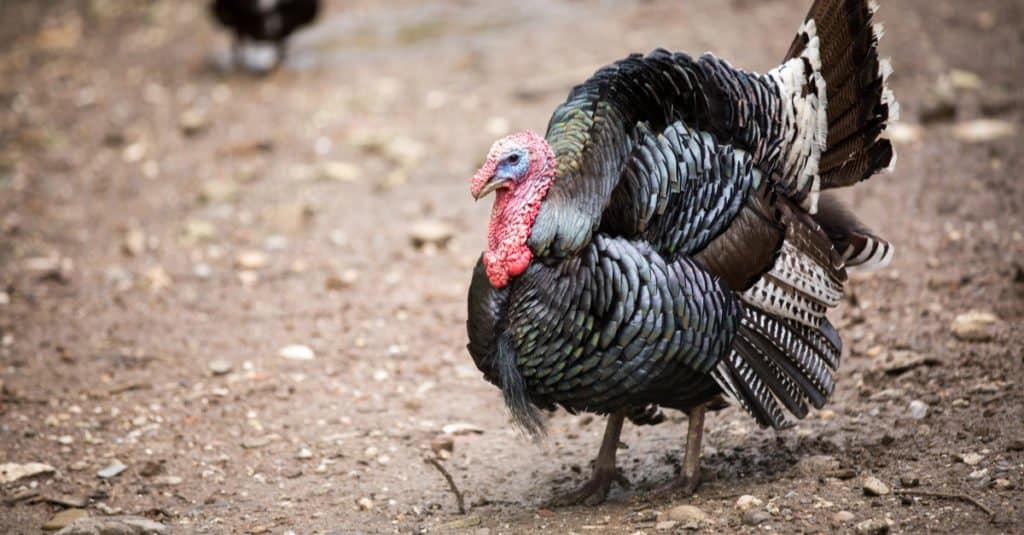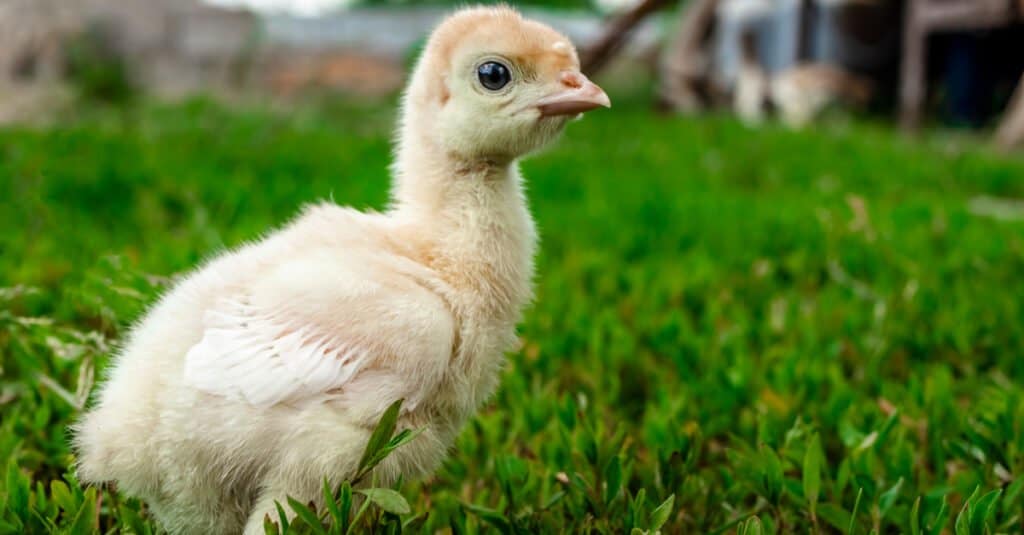As part of their Thanksgiving celebrations, families throughout America enjoy a traditional turkey feast every year. However, how much do we know about this ground-dwelling bird? We know that it’s a popular dish, but what do we know about this fascinating bird that has gorgeous coloring?
Want to learn more about this bird found throughout the United States? Let’s learn about the turkey lifespan and what factors impact how long they live out in the wild!
A Quick Rundown On Turkeys

Though they don’t fly very far, wild turkeys can fly and reach speeds of up to 55 mph.
©iStock.com/DA69
A turkey is a large bird that is known for its gobbling sound. But did you know that only a male turkey produces that famous sound? A female turkey—or a hen—will instead chirp like a chicken, yell when excited, or purr like a cat. The wild turkey has six subspecies, all native to North America.
Domesticated turkeys are now mostly bred for food. However, the birds were originally bred for their brilliantly colorful plumage until 1935. Turkeys not only have beautiful feathers, but they also happen to have a lot of them. A mature turkey has between 5,000 and 6,000 unique feathers on its body.
Also, while farmed-raised turkeys cannot fly, wild turkeys are very capable. While wild turkeys spend most of their time on the ground, they fly up into trees when nighttime approaches. Since turkeys can’t see that well at night, staying up in the trees keeps them safe from predators.
Now that we’ve learned the basics of turkeys, let’s explore the average turkey lifespan.
How Long Do Turkeys Live?

Turkeys live up to 4 years in the wild.
©Matthew Clemente/Shutterstock.com
In the wild, the average lifespan of turkeys is around 3 to 5 years. Turkeys in captivity may easily live between 10 years if properly cared for, depending on the breed of turkey. Unsurprisingly, domestic turkeys can have longer lives because of increased predator protection, a varied diet, and other considerations. However, if they are raised and grown in factory farms for meat production, they are frequently slain at around 5 or 6 months of age.
According to the Massachusetts Division of Fisheries and Wildlife Field Headquarters, the oldest wild turkey was a turkey discovered dead in Franklin County, Massachusetts, at 15 years old. That made it the oldest known wild turkey of any subspecies. Previous records ranged from 9.5 years for Merriam’s turkey to 14 years for Rio Grande turkey.
Now that we’ve learned everything there is to know about the lifespan of turkeys, let’s look at all of their life stages.
The Average Turkey Life Cycle
The average turkey lifespan can be broken into four stages: egg, poult, juvenile, and adult. Let’s take a closer look at each of these periods of a turkey’s life.
Egg
A turkey’s life cycle is pretty similar to other birds. Their life begins with an egg, which then takes about 28 days to hatch. A hen will usually lay anywhere between 7 to 14 eggs in a clutch, typically done toward the start of the summer. She will normally lay her eggs on the ground in a nest that she’s constructed for the occasion. The hen is exclusively responsible for the eggs, while the male turkey, also known as a tom, provides no assistance.
Poult
Unlike other birds, turkey offspring are not called chicks but instead are called poults. The poults must learn to fend for themselves from a very early age. They can usually walk only a few hours after hatching. Poults normally leave the nest within 24 hours. This leaves them exposed to lots of different predators as well. However, they are usually still protected by their mothers throughout this time. Poults may fly short distances and begin to roost in the protection of trees with their mothers after 14 to 30 days.
Juvenile
As the summer continues, the turkeys will begin to congregate in larger groups. The hen and her poults will eventually join a larger flock, sometimes numbering up to 200 birds. If the turkeys are living in higher elevations during this time, they will migrate to lower elevations and warmer climates. This allows the hen and her poults to survive the colder winter months.
Adult
By the end of the winter, the youngsters have matured into adults. This also means that the flock has fully dispersed as well. Young males will begin to create their breeding territory. Adult males will return to their breeding grounds, and hens will seek out males to breed with.
Males prefer to stay within a short radius of their breeding territory. However, hens will travel long distances in pursuit of a male.
What Factors Impact The Turkey’s Lifespan?

In the wild, turkeys’ lives are cut short due to predation and sickness.
©Waidelotte/Shutterstock.com
A number of variables determine the life expectancy of a turkey. Let’s take a look at the things that influence a turkey’s lifespan:
- Diet: The nutritional intake of turkeys has a significant impact on their lifespan. In the wild, turkeys eat a wide variety of nuts, seeds, and grasses. They also eat a variety of natural fruits like berries, insects, and even tiny reptiles. Turkeys in captivity require a lot of protein as well, especially when they’re developing. Healthy diets allow turkeys to grow and to maintain their energy in the wild. A turkey’s health will suffer if it doesn’t consume a nutritious, balanced diet high in protein.
- Environmental conditions: Turkeys have a limited lifespan in the wild due to predation, sickness, and hunting. The more turkeys wander for access to resources, the more vulnerable they are to these conditions. If a wild turkey lives in a location where it has easy access to food, it does not need to wander as far and will, as a result, be able to live longer.
- Genetic factors: A turkey’s lifespan can be influenced by genetic factors. Poor breeding and gene selection can lead to birds with slight walking difficulties. These difficulties are caused by hip or foot structural malformations.
The photo featured at the top of this post is © Jim Cumming/Shutterstock.com
Thank you for reading! Have some feedback for us? Contact the AZ Animals editorial team.






